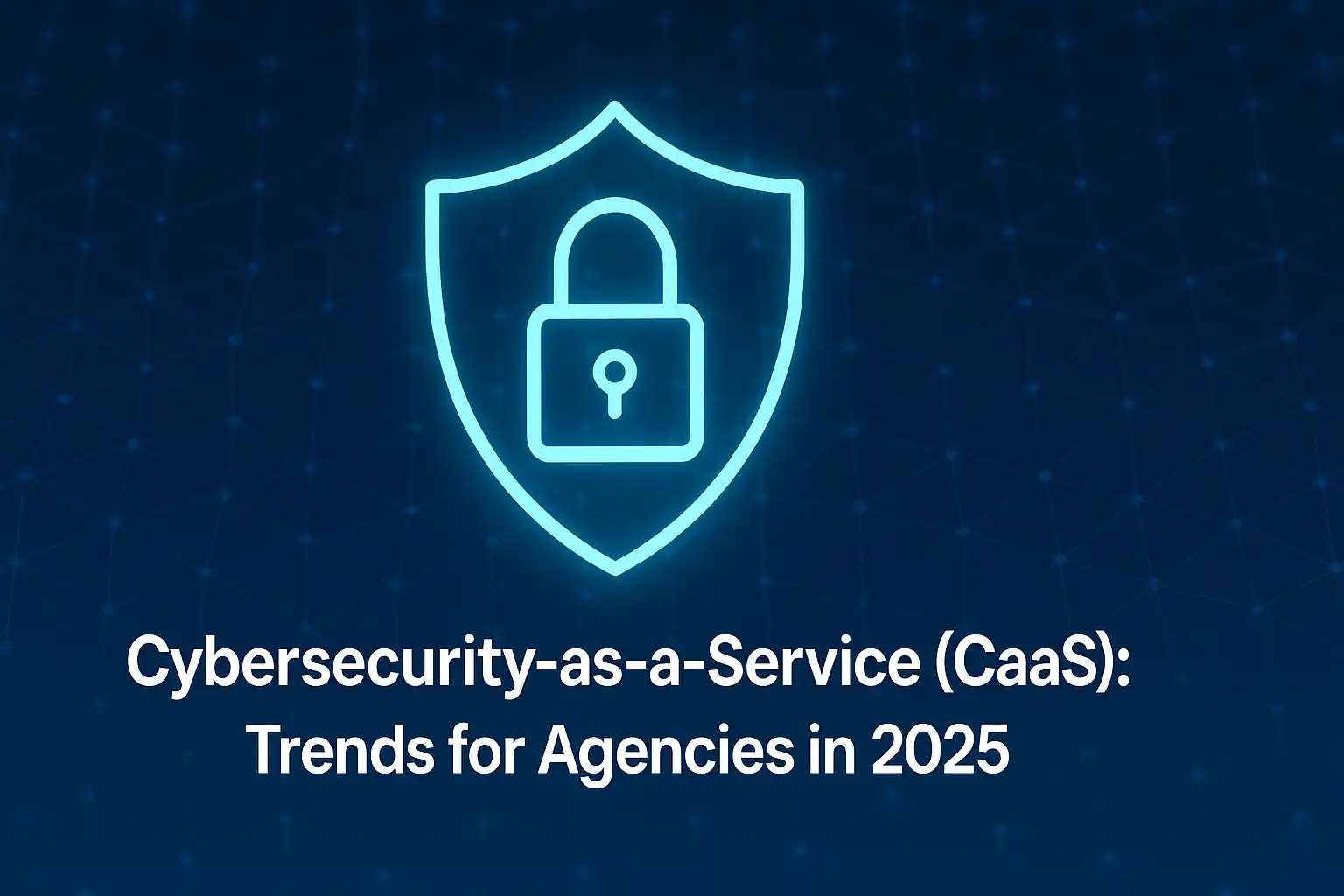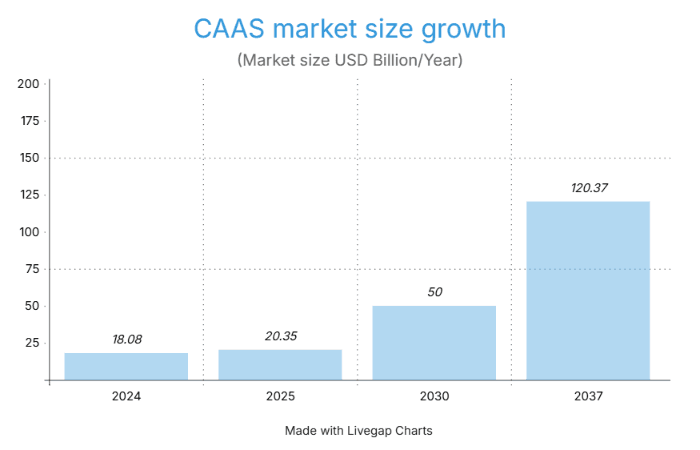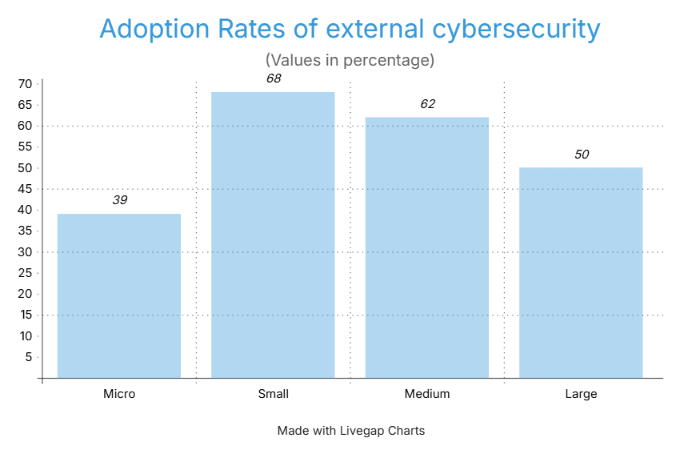
Sarthak Tyagi
Web Developer | AWS Cloud Architect

Discover the latest Cybersecurity-as-a-Service (CaaS) trends for agencies in 2025. Learn how CaaS protects your business, explore case studies, and leverage real-time statistics to stay ahead.
In an era where cyber threats evolve faster than most businesses can adapt, Cybersecurity-as-a-Service (CaaS) has emerged as a critical solution for agencies, particularly those with limited resources to combat sophisticated attacks. For founders, owners, entrepreneurs, and CEOs of marketing, design, or consulting agencies, protecting sensitive client data and maintaining trust are paramount. A single data breach can disrupt operations, damage reputations, and lead to significant financial losses. CaaS offers a subscription-based model that outsources cybersecurity management to expert providers, delivering advanced protection without the need for in-house expertise. This guide explores the definition of CaaS, its benefits for agencies, key trends shaping the market in 2025, real-world case studies, and actionable steps for selecting the right CaaS provider. Supported by real-time statistics and charts, this article provides a comprehensive roadmap for agency leaders to enhance their cybersecurity posture.
Cybersecurity-as-a-Service (CaaS) is a cloud-based, subscription model where third-party providers manage an organization’s cybersecurity needs. Unlike traditional in-house security, which requires significant investment in infrastructure and personnel, CaaS delivers services such as threat monitoring, incident response, vulnerability assessments, and compliance management through a scalable, pay-as-you-go framework. Providers operate Security Operations Centers (SOCs) staffed by experts who use advanced tools, including artificial intelligence (AI) and machine learning, to detect and mitigate threats in real time.
Agencies handle sensitive client data, including personal information, intellectual property, and campaign assets, making them attractive targets for cybercriminals. According to a 2024 report, 61% of small and medium-sized businesses (SMBs) experienced a cyber-attack, with 50% of attacks targeting SMBs due to perceived vulnerabilities (LastPass Blog, 2025). A data breach can lead to reputational damage, loss of client trust, and financial penalties, particularly if agencies fail to comply with regulations like GDPR or CCPA. CaaS addresses these challenges by providing enterprise-grade security tailored to the needs of agencies, allowing them to focus on delivering client services.
The CaaS market is evolving rapidly, driven by technological advancements and increasing cyber threats. Below are the key trends shaping CaaS for agencies in 2025, based on recent industry insights.
Small and medium-sized agencies are increasingly turning to CaaS to address resource constraints. The UK government’s Cyber Security Breaches Survey 2025 reports that 44% of businesses use external cybersecurity providers, with small businesses showing a rise from 56% in 2024 to 62% in 2025. This trend reflects the growing recognition among agencies that in-house security is often impractical due to limited budgets and expertise.
CaaS providers are integrating AI and machine learning to enhance threat detection and response. These technologies analyze vast datasets in real time, identifying anomalies and potential threats faster than traditional methods. For example, providers like Sophos and SentinelOne use AI to detect phishing attempts and malware, reducing response times by up to 96% compared to industry averages (Sophos, 2025).
Modern CaaS solutions are designed to integrate seamlessly with tools commonly used by agencies, such as customer relationship management (CRM) platforms, project management software (e.g., Asana, Monday.com), and cloud services (e.g., AWS, Google Cloud). This ensures that security measures do not disrupt workflows, allowing agencies to maintain productivity while staying protected.
With regulations like GDPR, CCPA, and HIPAA imposing strict requirements on data handling, CaaS providers offer tailored compliance solutions. These include automated audits, data encryption, and access controls to ensure agencies meet legal standards, avoiding penalties that can reach millions of dollars for non-compliance.
The subscription-based nature of CaaS allows agencies to scale security measures as needed, making it ideal for businesses with fluctuating workloads. Providers offer flexible pricing models, enabling agencies to access enterprise-grade protection at a fraction of the cost of in-house solutions, often saving 30-50% on security expenses (Research Nester, 2025).
To understand the value of CaaS, the table below compares it to traditional in-house cybersecurity for agencies:
| Aspect | CaaS | In-House Cybersecurity |
|---|---|---|
| Cost | Subscription-based, $500-$5,000/month | High upfront costs, $50,000-$500,000/year |
| Expertise | Access to dedicated security experts | Requires hiring and training staff |
| Scalability | Easily scalable with business needs | Limited by internal resources |
| Technology | Advanced AI and analytics included | Requires separate investment in tools |
| Compliance | Built-in compliance support | Manual compliance management |
| Response Time | 24/7 monitoring, rapid response | Dependent on internal team availability |
This comparison highlights CaaS’s advantages in cost, expertise, and scalability, making it a compelling choice for agencies.
The following case studies illustrate how CaaS can protect agencies from cyber threats, drawing from real and hypothetical scenarios based on common agency challenges.
Challenge: ConnecTheDot, a U.S.-based marketing agency, suffered a devastating cyber-attack in 2023 where bot farms hijacked website traffic for ad revenue, leading to financial losses and eventual closure (Cybersecurity Case Studies, 2025).
Solution with CaaS: A CaaS provider could have deployed web application firewalls (WAFs) and real-time traffic monitoring to detect and block malicious bot activity, preserving the agency’s operations and client trust.
Outcome: With CaaS, the agency could have avoided closure, maintaining revenue and reputation.
Challenge: All Things Web, a UK-based marketing agency, needed to protect client data and achieve Cyber Essentials certification to qualify for government tenders (Absolutely PC, 2021).
Solution with CaaS: Partnering with a CaaS provider, the agency implemented endpoint protection, email security, and compliance tools, achieving certification without an in-house security team.
Outcome: Certification increased client confidence and enabled the agency to secure new contracts, boosting revenue by 20%.
Challenge: A mid-sized agency experienced a phishing attack where employees’ credentials were stolen, compromising client data and disrupting campaigns.
Solution with CaaS: A CaaS provider implemented advanced email filtering, multi-factor authentication (MFA), and employee training programs to prevent phishing attempts.
Outcome: The agency avoided data breaches, maintaining client trust and reducing potential losses by 80% compared to similar incidents.
Challenge: A ransomware attack encrypted the agency’s files, halting operations and demanding a $50,000 ransom.
Solution with CaaS: A CaaS provider offered endpoint protection, automated backups, and rapid incident response, restoring systems without paying the ransom.
Outcome: Operations resumed within hours, saving the agency from significant downtime and financial loss.
Challenge: A DDoS attack took down the agency’s website during a high-profile campaign launch, causing reputational damage and lost revenue.
Solution with CaaS: A CaaS provider deployed DDoS protection services, absorbing malicious traffic and ensuring website availability.
Outcome: The campaign launched successfully, preserving client relationships and avoiding an estimated $100,000 in losses.
The CaaS market is experiencing significant growth, driven by rising cyber threats and the need for accessible security solutions. Below are key statistics and trends for 2025, supported by recent data.

© Gautam IT Services

© Gautam IT Services
These statistics highlight the growing importance of CaaS for agencies, particularly as cyber threats become more sophisticated and frequent.
Selecting a CaaS provider requires careful consideration to ensure alignment with agency needs. Key factors include:
Questions to ask potential providers:
Cybersecurity-as-a-Service (CaaS) is transforming how agencies protect their digital assets, offering a cost-effective, scalable solution to combat evolving cyber threats. With trends like increased SMB adoption, AI-driven security, and seamless tool integration, CaaS is well-suited for agencies handling sensitive client data. The case studies demonstrate the devastating impact of cyber-attacks and how CaaS can prevent or mitigate such incidents. As the CaaS market grows from USD 18.08 billion in 2024 to USD 20.35 billion in 2025, and with 44% of UK businesses already using external providers, agencies have a clear opportunity to enhance their security posture. By selecting the right CaaS provider, agency leaders can safeguard their operations, maintain client trust, and focus on delivering exceptional services in 2025 and beyond.